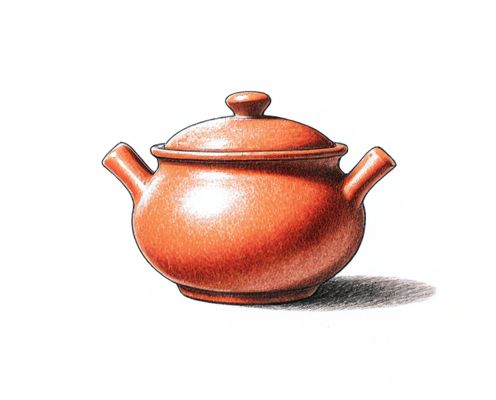
Japanese clay pot Illustration
Japanese clay pots, known as donabe, offer exceptional heat retention and even cooking, making them ideal for slow-simmered dishes and stews. Their porous material allows for gradual moisture release, enhancing flavors and preserving nutrients. Durable and versatile, donabe pots can be used on stovetops or in ovens, adding authentic taste and traditional appeal to any kitchen.
Introduction to Japanese Clay Pots: Heritage and Evolution
Japanese clay pots, known as donabe, have been crafted for centuries using traditional techniques passed down through generations. These earthenware vessels combine natural materials like clay and fire-resistant minerals, offering excellent heat retention and even cooking. The evolution of donabe reflects Japan's cultural heritage, blending artisanal craftsmanship with modern adaptations for versatile use in kitchens worldwide.
The Art of Japanese Clay Pot Craftsmanship
Japanese clay pots, known as donabe, exemplify centuries-old craftsmanship combining natural volcanic clay and traditional firing techniques for exceptional heat retention and durability. Artisans meticulously shape each donabe by hand, ensuring unique textures and finishes that enhance cooking performance and aesthetic appeal. This artisanal process preserves cultural heritage while delivering superior kitchenware prized for slow-cooking soups, stews, and rice dishes.
Unique Materials and Techniques in Japanese Clay Pots
Japanese clay pots, known as donabe, are crafted using special clay sourced from specific regions such as Iga and Shigaraki, renowned for their heat retention and distribution properties. Artisans employ traditional hand-building techniques combined with natural ash glazes that enhance durability and non-stick surfaces over time. Your cooking benefits from these unique materials and methods by achieving even heat, rich flavors, and long-lasting performance.
Culinary Benefits of Cooking with Japanese Clay Pots
Japanese clay pots, known as donabe, offer exceptional heat retention and even distribution, enhancing the natural flavors of ingredients during slow cooking. Their porous material allows moisture to circulate, resulting in tender, juicy dishes with rich umami taste. These clay pots are ideal for preparing soups, stews, rice, and hot pots, preserving nutrients and delivering authentic Japanese culinary experiences.
Health Advantages of Clay Pot Cooking for Women
Japanese clay pots, known for their natural, non-toxic materials, preserve nutrients and enhance flavors without the need for excessive oil or salt, promoting heart health and weight management among women. The porous structure ensures even heat distribution, which helps retain vitamins and minerals essential for hormonal balance and skin health. Clay pot cooking also reduces the formation of harmful compounds often generated by metal cookware, supporting overall female wellness and digestive health.
Classic Japanese Dishes Made in Clay Pots
Master traditional flavors with a Japanese clay pot, known as donabe, essential for authentic dishes like sukiyaki, shabu-shabu, and rice porridge. The porous clay ensures even heat distribution and moisture retention, enhancing the taste and texture of stews, soups, and simmered vegetables. Your culinary skills will elevate as the pot's natural materials preserve heat, delivering rich, slow-cooked flavors true to classic Japanese cuisine.
Modern Kitchen Integration: Adapting Clay Pots to Contemporary Cooking
Japanese clay pots, or donabe, seamlessly blend traditional craftsmanship with modern kitchen technology, making them ideal for contemporary cooking. Their heat retention and even cooking properties enhance flavors, while compatibility with gas, induction, and electric stoves ensures versatility. By incorporating a donabe into Your kitchenware collection, You combine timeless durability with innovative culinary techniques.
Choosing the Right Japanese Clay Pot for Your Kitchen
Selecting the right Japanese clay pot for your kitchen involves considering factors like size, heat retention, and material quality to enhance cooking performance. Donabe clay pots, made from porous clay, offer excellent heat distribution and are ideal for simmering or steaming traditional Japanese dishes. Your choice should match your cooking style and cuisine preferences, ensuring durability and versatility in everyday use.
Care and Maintenance Tips for Japanese Clay Pots
To preserve the durability and natural seasoning of Japanese clay pots, avoid using soap or harsh detergents; instead, rinse with warm water and gently scrub with a soft brush. After cleaning, allow the pot to air dry completely before storing to prevent mold growth and cracking. Regularly season the pot by boiling rice water or tea leaves, which enhances its non-stick surface and enriches the pot's flavor absorption properties.
Empowering Home Cooks: Japanese Clay Pots as a Kitchen Essential for Women
Japanese clay pots, known as donabe, offer superior heat retention and even cooking, empowering home cooks to prepare nutritious and flavorful meals with ease. Their versatile design supports simmering, steaming, and slow-cooking, making them an essential tool for women seeking traditional yet efficient kitchenware. Crafted from natural materials, these pots enhance cooking precision while promoting healthier, chemical-free food preparation.
 womendy.com
womendy.com